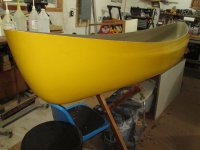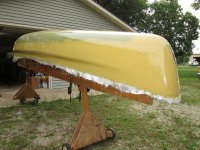G
Guest
Guest
I also don't do a lot of things I have read in this thread others do, like fill in the old screw holes on the hull, varnish the inside of bolt and screw holes on wood work (how do you get varnish into a 16th inch pre drilled hole on a new ash gunnel?).
I don’t always run a piece of glass tape over the old screw holes. But, on a composite hull had previously been regunwaled once before, there are already 60 or 70 holes existent along each often thin FRP sheerline.
Holes either spaced close together (sometimes so close together that the old holes overlap in weakly fashion), or even when spaced every three inches apart from the OEM holes, then I do lay 2” glass tape at the sheerline. There is a clean easy trick to doing laying down that epoxy saturated tape.
I’m going to drill another 30 holes just below each sheerline when installing new gunwales. On a canoe that has been regunwaled once before, ending up with 100 unreinforced holes on each side seems suspect.
I have enough math trouble calculating evenly spaced horizontal gunwale holes that don’t end up too close to vertical machine screw holes for seat drops, thwart and yoke hardware. Finagling how to miss a Swiss cheese of old holes with new gunwale screws is beyond me. What I really want to avoid is my new holes overlapping/intersecting with old holes, or worse, intersecting a pair of old holes already too close together, making three married weaklings.
I don’t try to varnish inside the pilot holes on the outwales, but the pre-drilled holes and countersinks in the inwales do get treatment. That is just drilled raw wood, and another suspect place for decay to form.
The machine screw holes on seats, seat drops, thwarts and yokes get several coats of varnish (or spar urethane), applied inside the holes using a pipe cleaner when I am varnishing. I drill those holes 1/64” larger than the (usually) 3/16” machine screws to accommodate some interior sealant coats.
Perhaps most critically the thirsty butt ends of seat drops, thwarts and yokes get the bejeepers sealed out of them. As many coats of varnish/urethane as I can stand, or sometimes a couple coats of epoxy. The first coat or two of sealant sucks into the butt end raw wood, like the first coat of contact cement vanishing into minicel.
I understand why manufacturers don’t seal those holes very well, if at all. I can manage to get two coats of urethane in those holes/on those ends per day, times threefourfive coats, so two or three days spent just on that.
Said no one ever at Mad River, Wenonah, Old Town, etc “Let’s just stop outfitting work on this hull for a couple days while the varnished holes and ends of the brightwork dries”
I don’t expect that from mass boat builders. Although I kinda hope pricey niche builders, where you order a canoe and they then build it for you, take that extra time. Me, I usually got an couple days to spare when putting a canoe back together, especially if it is a boat for me or a friend.
Lastly, seriously, anyone who has bought a new, or newish, canoe with wood brightwork - unscrew the yoke or a thwart and have a look at the butt end sealant application. Hint: If you take that stuff out one piece at a time it goes back in easier.
If you don’t like what you see sealant-wise coatings on the yoke, sand the ends baby’s arse smooth; too often the butt ends of that stuff from big manufacturers looks open-grain never been sanded. Again, I understand where manufacturers are coming from.
That ain't workin' that's the way you do it
Money for nothin' and chicks for free
Now that ain't workin' that's the way you do it
Lemme tell ya them guys ain't dumb
Drill out the machine screw holes 1/64” larger, or even 1/32” larger than the hardware. Multi-coat the crap outa the now smooth brightwork butt ends, and pipe-cleaner some sealant inside the hardware holes at least a few times
Put the yoke back in, take out a thwart and repeat. If you want to save time and do everything at once you can put a couple of long bar clamps across the gunwales to hold the yoke-less, thwart-less floppy canoe in relative sheerline shape.
I would definitely do wood seat drops and frames separately; that stuff is a little trickier to get re-installed if the hull has thwart-less/yoke-less lost shape.
Lastly, lastly, 800 words later, if the ends of your yoke or thwarts are showing any hint of creeping bacterial rot black the time is now, before a minor pin or wayward bump busts out those rotting end cross pieces.




